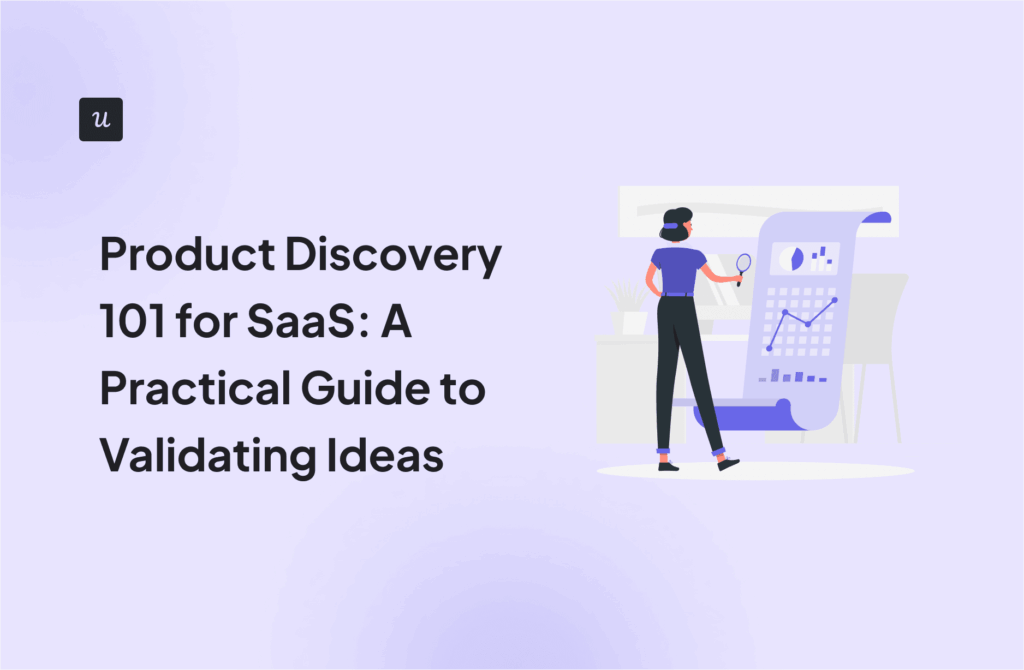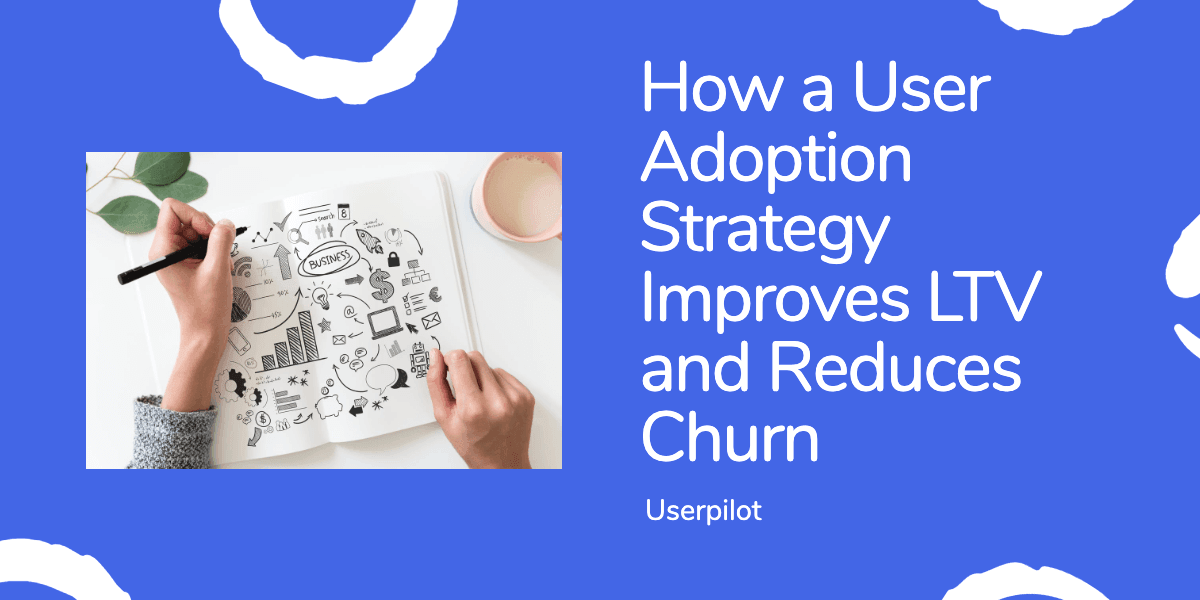
If I asked you to think of the most important aspects of creating a successful SaaS product, you’ll probably think of solving a need, user onboarding techniques, and the all-important product-market fit.
Well, I have another one in mind… creating the perfect user adoption strategy.
It may sound obvious but ensuring that your users fully adopt your product is essential to its success.
A great user adoption strategy will help you achieve that level of adoption with your users.
In this article, I’m going to show you how to create your user adoption strategy!
Try Userpilot Now
See Why 1,000+ Teams Choose Userpilot

What is a user adoption strategy?
In its simplest terms, a user adoption strategy is the plan you put in place to help users adopt your product.
The actual answer is a little more complex.
There are lots of SaaS products out there, covering all kinds of bases and industries. But what if I told you they were ultimately all the same?
That’s right. Hubspot, Drift, even our very own Userpilot — every SaaS product can be condensed into one sentence.
Here’s that sentence:
“[PRODUCT] helps [USERS] to [GOAL].”
It’s that simple. Every SaaS product is designed to help people achieve a goal.
Here are some examples…
- Hubspot helps marketing and sales teams to align and grow.
- Drift helps marketing and sales teams to generate more leads.
- Userpilot helps product teams to increase user adoption.
Here’s a top tip, visit the homepage or landing page of any successful SaaS company and they’ll have some variation of this sentence there for you to see.
So, what does this have to do with user adoption strategies?
Well, if you want your users to adopt your product, you need to figure out their motivations and requirements. You need to help them achieve their goals.
A great user adoption strategy lays out all the information you have about your users’ wants and needs. It then provides you with a framework you can use to drive adoption of your product.
A user adoption strategy is a roadmap that helps you develop a product that people want to use.
Why every SaaS company needs a user adoption strategy
I know you’re dying to find out how to create your user adoption strategy, and I promise I’ll get to that soon.
But before that, I want to make it clear that your user adoption strategy is incredibly important.
While it’s true that a lot of SaaS companies focus overwhelmingly on growth and acquisition, that generally isn’t the reason for long-term success.
You can have the most effective growth machine in the world, bringing in hundreds, maybe even thousands, of new users each month.
But if those users aren’t fully adopting your product, then that growth will eventually end in churn.
And, as we all know, churn is the biggest SaaS killer…
- High growth and high churn is exciting but it isn’t sustainable.
- Low growth and low churn isn’t exciting but it is sustainable.
- Low growth and high churn is a disaster.
- High growth and low churn and you’re a unicorn, my friend!
So you see, while growth is important, avoiding churn actually has a larger impact on the success of your SaaS product.
I know this goes against a lot of what people hold true about SaaS products.
But it makes sense, right?
Some products see incredible growth, but they fail to retain their users — because they never actually adopted the product — and so they die out as quickly as they grew.
You might have even experienced this first-hand, and wondered what could possibly have gone wrong.
Well now you know… It’s because acquiring your users is only one step. Real success comes from making sure those users fully adopt your product.
A user adoption strategy will help you to do that.
How to create a user adoption strategy that actually works
Alright so here’s the part you’ve been waiting for. Here’s how you can create a user adoption strategy for your product.
The first step is research…
Step 1: Use research to understand your users’ needs
You might think you know what your users need, but unless you actually take the time to conduct some research, it’s all based on guesswork.
Consider the example of the founder of a new email app, we’ll call him Jim. Jim believes that his users want to better organize their inbox. So he adds in tagging functionality. He thinks his product solves his users’ needs.
Unfortunately, Jim failed to actually do any user research. As a result, he got his users’ needs wrong. It turns out that his users need a faster way of reading through their emails. Jim’s tagging functionality does the exact opposite.
Jim’s users wanted less work, but Jim’s product gave them more work to do.
This is a crude example, but it’s not wholly removed from what I’ve seen with various SaaS companies.
Assuming you know what your users truly need is a big gamble, and one you really don’t need to take.
Instead, before you even decide how you’re going to develop your product, you need to speak to your users.
Step 2 in creating a user adoption strategy: Speaking to your users
Choose some of your most successful users, and schedule in some time to sit down with them and chat. You should try to uncover what they currently need from your product, and what they may need differently in future.
You’ll find that most, if not all, users will be happy to help you out.
You don’t need to spend weeks doing this. A ten minute conversation with 15-20 users should provide you with more than enough qualitative data to start making decisions.
At this point, you should have some key patterns and common needs that keep cropping up from user to user.
These key features will generally overlap perfectly with your product’s Aha! Moment — the moment your users fully grasp the value of your product.
Related: The Aha! Moment Guide for Product Onboarding
This should give you a number of directions in which you can potentially take your product.
But how do you decide which is the best option?
Well, that’s where quantitative data comes in…
Step 3: Surveying your users
You can now send out a survey, either by email or even within your app itself.
The survey should include the different needs that your users came up with when you spoke to them.
You can then ask survey users to choose which of those needs they require the most. Which is their biggest priority?
A survey like this enables you to scale up your research and include as many users as possible. When it comes to quantitative data, the more the merrier.
Mobile surveys are a quick way to measure customer satisfaction, gather real-time feedback, and boost engagement.
After a load of users have filled in your survey, you’ll be left with something incredibly useful when it comes to creating a user adoption strategy…
You’ll have a list of your users’ biggest priorities about what they need from your product.
That’s an amazing insight, and it hardly took you any time or resources to reach it!
Step 4: Subtly assess the level of need
Some SaaS founders and product owners can be a little protective of their ideas.
Despite the fact that execution always trumps ideas (which is probably an article in itself!) people in the SaaS world are often scared that their ideas will be taken, that someone will beat them to market.
If that’s the case, there is a subtle way of measuring the demand for a new feature you’re planning to build.
The best way to explain this is with an example.
Ecomply was set up to make GDPR easier to understand, and to help companies become GDPR compliant.
The team at Ecomply had this idea that there might be a marketplace for “Data Protection Officers (DPOs)-as-a-service”.
In other words, rather than assigning a member of your team to be your DPO, Ecomply would provide you with an external DPO service.
But Ecomply weren’t entirely sure there was enough demand for such a feature.
Keen to protect the idea from prying eyes, they decided they would build a “fake door” into their sign-up process on their site.
Here’s what it looked like:
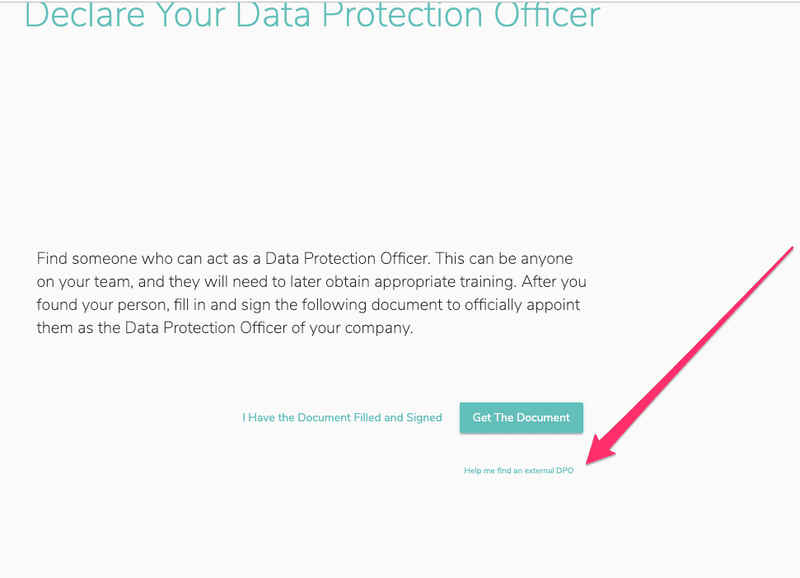
As you can see, the team at Ecomply placed a smaller CTA underneath the primary one.
Clicking on this CTA opened up the messaging widget with the following message:
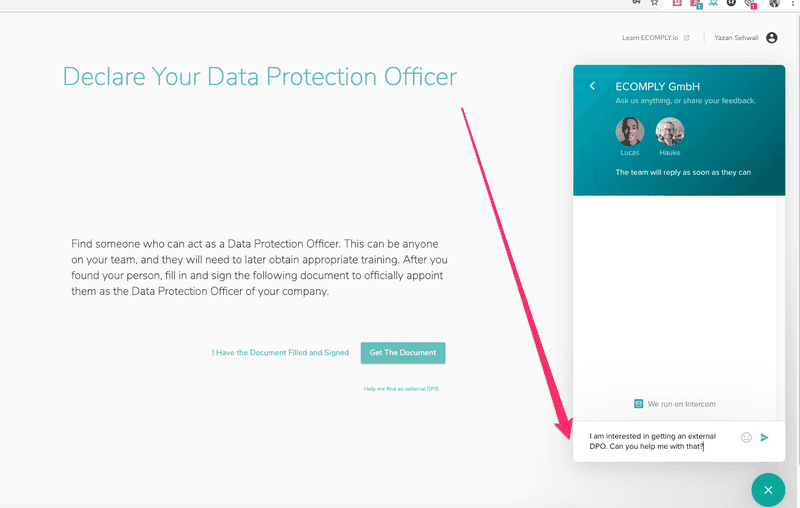
This was a subtle way for Ecomply to gauge the market.
As it turned out, interest was fairly small, and so they decided not to build the feature.
A tiny bit of research saved Ecomply a load of time and money.
But you shouldn’t only be researching potential new features…
Step 5: Conduct a feature audit to identify key product areas
I’m assuming that you already have a product in place, with some regular users.
If you don’t, then for now you can skip this section.
So, what is a feature audit, and how does it help you create your user adoption strategy?
A feature audit is, as the name suggests, an audit of your existing features.
It’s essentially a way for you to understand which of your features are resonating the most with your users. Which features are getting the most engagement?
A basic feature audit looks a little like this:

Along one axis you have the number of users who use a feature. Along the other axis you have how often the feature is used.
Features that occupy the top-right segment are your most useful features. These are features that most users use, most of the time.
Features that occupy the top-left segment get a lot of use from those who know about them, but unfortunately not a lot of users know about them.
Features that occupy the bottom-right segment are used by lots of users, but not very often.
And finally, features that occupy the bottom-left segment aren’t used by many people, or even that often.
So, what’s the point? How does this help you?
Step 6 to creating a user adoption strategy: How to use your feature audit
Well, it actually provides you with some really useful insights!
It shows you where you need to focus your efforts when it comes to your user adoption strategy.
The top-right features are already widely used. Your users are already engaging with them. They don’t really need anything else. You’re better off focusing elsewhere.
The top-left features seem to be really useful for a select number of users. Chances are they’d be useful for other users too, the issue is they simply don’t know they exist.
This is where your user adoption strategy comes in. You can start educating your users about these features. That way more users will adopt them, and gain more value from your product. That’s what keeps them coming back for more, increasing your LTV, and decreasing your churn rate.
The bottom-right features are used by a lot of users, but not very often. Generally, that’s because the features aren’t useful enough. Perhaps they aren’t fulfilling your users’ key needs.
In that case, you’re better off promoting them less, or improving them to better cater to your users’ needs.
As for the bottom-left features, these haven’t got any traction at all. As a result, you should consider dropping them completely. Clearly there isn’t a valid use case for them.
A feature audit is well worth your time. It shows you where to focus your efforts when it comes to creating your user adoption strategy.
There’s some great advice from Brian Rhea in this episode of the UI Breakfast podcast.
We also recommend signing up to the beta of this feature auditing software.
Step 7: Decide how you’re going to onboard users to your new or existing features
User onboarding is the most effective way of nudging your users towards product adoption.
The best user onboarding flows educate users about what a particular feature does, and then encourage them to try it out for themselves.
There are lots of different methods that SaaS companies can use to onboard their users. These include tooltips, checklists, slideouts, modals, and guided walkthroughs.
We’ve written quite a lot about the different user onboarding techniques on our blog, so I’m going to briefly explain what a few of the most common techniques are, and how you can use them as part of your user adoption strategy.
Step 8: Use tooltips to highlight certain areas of your product
Tooltips can be really useful when it comes to onboarding users and improving user adoption.
They are best used to highlight specific areas of your product and for guiding users through a series of steps.
Here’s a great example from Quora:
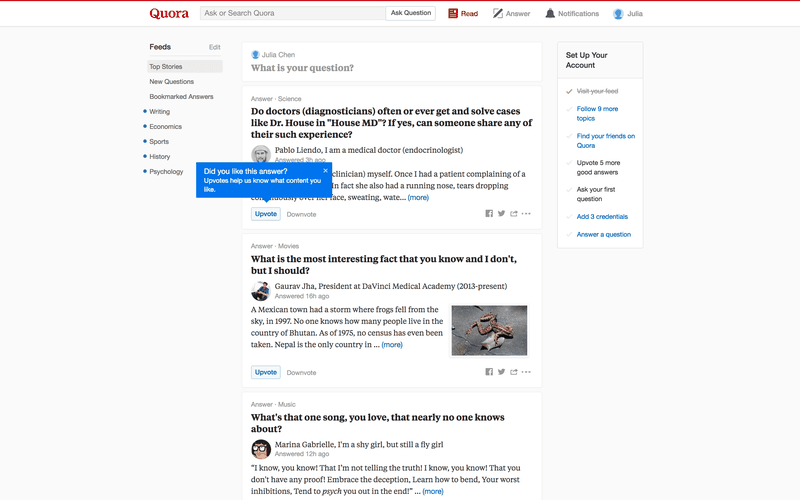
One of the key aspects of Quora is a user’s ability to upvote responses.
In fact, it’s really important that users learn about upvoting, because that’s what Quora uses to figure out which content a user is interested in.
If Quora can show you more relevant content, you’re more likely to stick around.
That’s why this tooltip works so well. It establishes what it wants a user to do (upvote) but also explains the benefit to the user (showing them more relevant content).
From a design point of view, the blue is a stark contrast to the rest of the site, and so users can’t help but notice it.
Use tooltips to draw your users’ attention to key elements of your product.
Step 9: Use slideouts and popups to educate your users
Slideouts and popups are a simple yet effective way of educating your users about your product.
Education is an important step in any user adoption strategy; the more a user understands your product, the more likely they are to adopt it.
Here’s a perfect example from our friends at Hotjar:
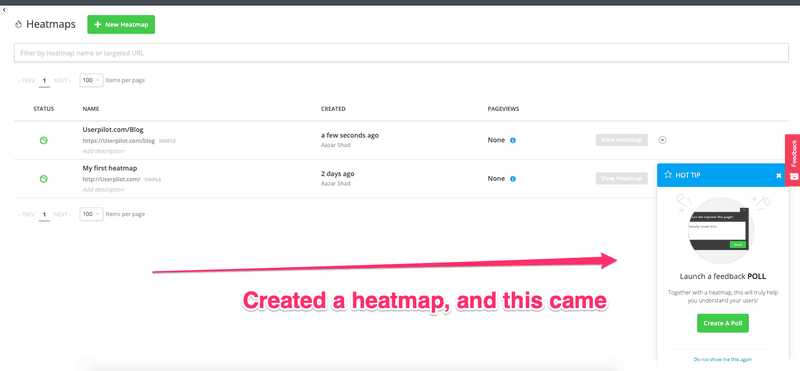
After you create your first heatmap, Hotjar shows you this popup. It explains that a best practice for using Hotjar is to run a poll alongside a heatmap. This improves the data you collect.
This is a clever use of a popup onboarding element. It’s contextual, only appearing after the user takes a relevant action, which means it’s more likely to drive user adoption.
Also, it has a strong and clear CTA, enabling users to get started with a poll with a click of a button.
The more you educate your customers, the more they’ll stick around and use your product. Slideouts and popups are a great way of doing that.
Step 10: Use modals to announce a specific feature
Modals are similar to slideouts and popups, in that they enable you to educate your users.
But, because modals often take up the whole screen, you have a lot more space to play around with.
That’s why modals are perfect for announcing new features, or for highlighting existing ones.
Check out this example from Webflow:
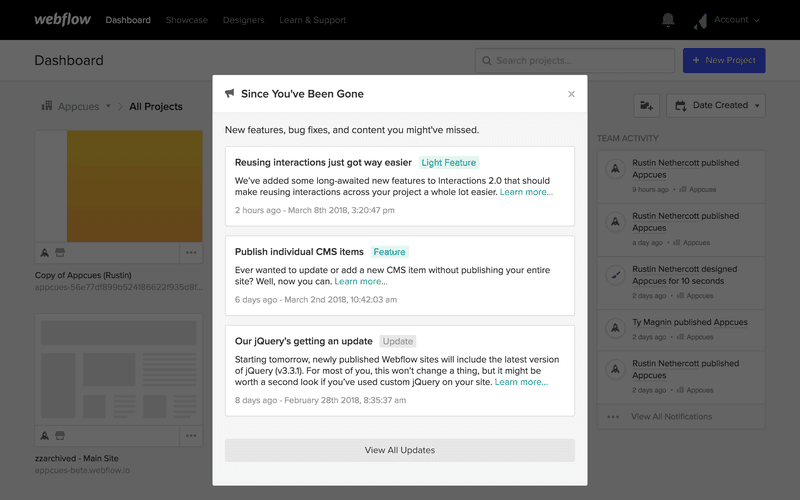
If you haven’t logged in to Webflow for a while before returning, you’ll see this modal.
It lists out all the major changes to the product since you went away. It even color-codes them by category.
Clicking any of the links will take you to a page where you can learn more about the new change.
This is a really clever way of showing off new features and elements of their product.
Unlike a lot of poorly designed modals, Webflow has made one that is clear and compact, telling users everything they need to know.
This helps new and returning users alike catch up to speed with how Webflow has developed, and it encourages them to dive in and start using the product.
Modals should be used with caution — use them too often and you’ll end up annoying your users. But a modal done well can drastically improve your activation rate and adoption.
Step 11: Use guided tours to encourage user adoption
One of the most effective ways you can encourage user adoption is to create a guided tour that new users have to follow.
A great guided tour will show the user how to use the feature while also explaining why it’s so useful. Think of them as part help doc, part sales pitch.
Here’s a fantastic example from Zuora:
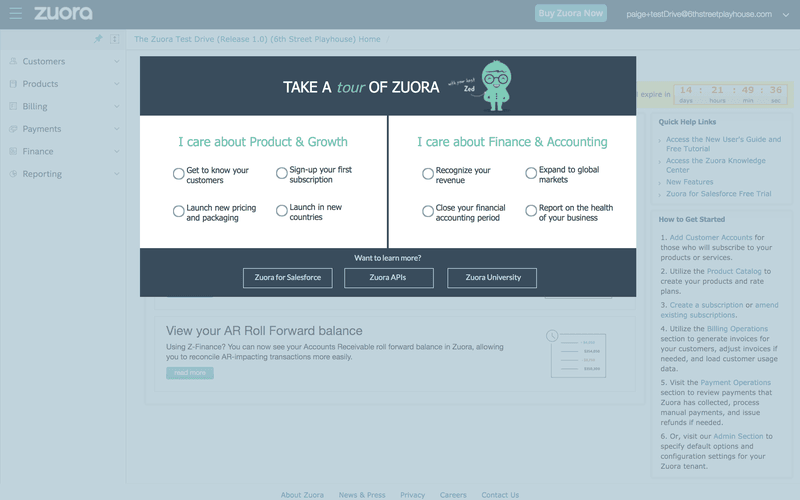
Zuora offers a lot of different features, each aimed at a different people. Rather than giving the same irrelevant tour to each and every user, Zuora gives people the choice.
Once the user has chosen their tour, Zuora will guide them through the key parts of the chosen feature.
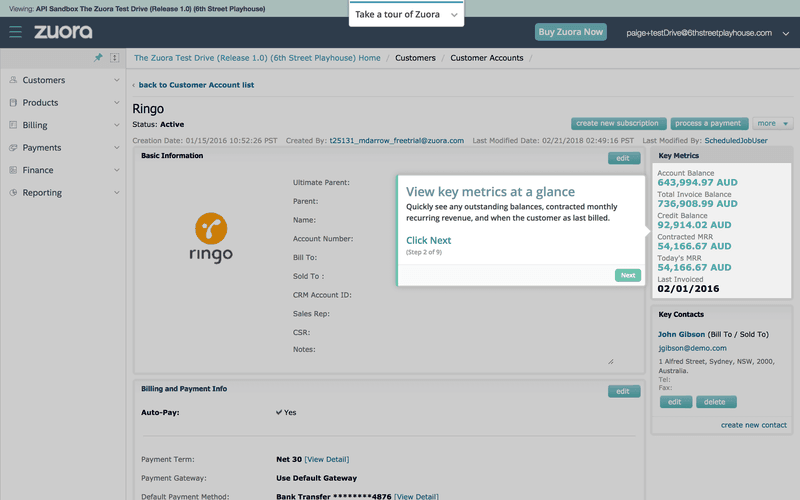
Using dummy data, Zuora is able to show new users exactly how it’ll work when it comes to using their own data.
Each step of the tour educates the user, and gives them a thorough understanding of how it all works, and why it’s such a useful tool.
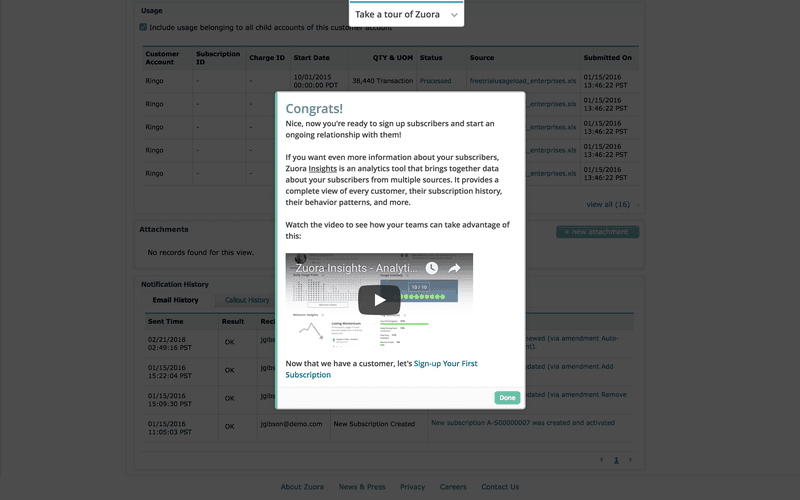
At the end of the tour, Zuora offers the user a video on how to make the most from the product, and then encourages the user to get started.
As you can see, guided tours can be extremely useful when it comes to driving adoption. You should definitely consider using one when you come to create your user adoption strategy.
Tip: Add new products to increase user adoption
SaaS products need to continually expand into new areas if they want to survive long-term.
Provided any new products you add are relevant to your existing users, you’ll find that shipping new products can be a big driver of user adoption.
If you think about it, this makes a lot of sense…
The more products you have, the more chances you have to really wow your users and nudge them towards fully adopting your software.
A new product may tap into one of your users’ key needs and requirements, and so will obviously be adopted.
The research you did as part of your user adoption strategy should actually give you some good ideas of new products you could build.
It might seem drastic to release a whole new product in an attempt to drive user adoption, but if it works then it really works.
Don’t believe me?
Consider Drift, which was originally a chat widget. Now they offer automation with bots, and recently launched Drift Video.
These new products enhance the existing ones, and provide users with even more firepower. In a sense, it gives them more superpowers, and as a result they stick around for longer.
If you want a more concrete example, then look no further than Userpilot itself.
A while ago we launched “checklists” as a new product. Simply releasing this new product alone helped us to save 40% of “at-risk” users, and became another key differentiator for our product.
Tip: Integrate with as many products as possible
According to the folk at ProfitWell, products with at least one integration have 10-15% higher retention.
In fact, generally the more integrations your product has, the more users adopt it.
The reason for this is quite straightforward…
Most people who use one SaaS product, probably use quite a few of them. I know I do. SaaS people often end up collecting other SaaS products like Pokemon cards.
But using all of these SaaS tools is difficult if they don’t talk to each other.
If I can’t link my Google Calendar to my meeting app, then that’s a lot of manual work that needs to be done. If that was the case with every SaaS product I used, then I’d spend all my time linking them together.
ProfitWell found that for every integration you add to your product, you increase retention by an additional 4-7%.
Adding integrations to your product is a no-brainer. Not only does it improve your product offering, but it also helps to drive user adoption and increase retention.
Tip: Create academies to drive SaaS adoption
While a lot of SaaS companies focus on making improvements to their product or onboarding in an attempt to increase user adoption, there are a couple of effective out-of-app techniques you can use.
One of these is to create an academy. An academy is essentially a course that guides your users through the product.
Rather than having separate and distinct help docs, you combine all your knowledge into a course (or multiple courses).
Users can then work through the course in order to learn how your product works, and more importantly, how to get results.
This can lead to high levels of user adoption.
Planfix use AcademyOcean to create an academy for their collaboration tool. It took them about a month to create and implement the academy, and the results were incredible.
Creating just one academy course improved conversion rates from trial to paid user from 17% to 25% — that’s a growth of 47%!
That’s an impressive improvement in user adoption.
Tip: Communities to improve user adoption
The other out-of-app technique is to start a community built around your product.
Communities work extremely well with more complicated product offerings. Google and Salesforce, for example, both have dedicated communities for their products.
A community is kind of like a forum for your users to hang out. They can ask questions and your support team can field them.
Eventually, however, these communities can become self-sustaining. Users will start helping out other users.
Thus, it becomes a place where users can learn more about your product, and find help when they get stuck.
This worked extremely well for SimScale. They founded a community which ended up becoming the largest simulation community in the world! Now they have more than 150,000 users worldwide, and these users created 223,000 public projects. It also helped them with their SEO efforts and contributed to 200% organic growth and 150% growth in marketing qualified leads in one year (Data from Agata Kristo former Marketing Director of SimScale).
This provided them with a number of benefits:
- They were essentially receiving free marketing for their product.
- Posts on the forum were ranking well on search engines.
- Users were helping each other.
- People would ask questions that the SimScale team hadn’t considered.
All of that, plus the fact that they saw an increase in user adoption.
Creating an academy or community might seem like a lot of work at first, but you generally have the content you need in help docs.
If you’re going to implement one (or both) of these options, make sure you plan it out in advance and have a dedicated team or owner is going to take care of it and manage it properly.
Done well, these will drastically improve user adoption and also help you form long-lasting relationships with your customers.
Put a system of measurement in place to see the effects of your user adoption strategy
The final piece of your user adoption strategy is also the most important.
The reason you’re creating the strategy in the first place is to improve your user adoption, right?
So it’s important that you actually have a system in place which enables you to measure how successful your strategy is.
And, like any measurement of success, it starts with a goal…
Set goals for your user adoption strategy to hit
You work in SaaS, so this probably goes without saying, but you need to consistently be setting goals and targets to aim for if you want to measure success.
When it comes to crafting your user adoption strategy, your goals are the most important step.
No goals means no measurement. Bad goals means bad measurement. But good goals, well now we’re talking.
So what is a good goal to have on your user adoption strategy?
Like any good goal, it needs to be specific, relevant, and measurable.
Clearly the whole point of this is exercise is to improve user adoption. Unfortunately that’s not quite specific enough.
You need to think about what adoption actually means for your product.
For an email marketing product, that might be when a user sends their first email.
For a social network, it might be when a user adds X number of friends.
To find out what your metric should be, you need to use tools like Heap or Mixpanel. The in-depth product analytics that these tools provide will enable you to see the point at which users tend to stick around for the long-term.
Users with high LTVs have obviously fully adopted your product. So you need to learn which features they used to get there.
So now you have a more specific metric in mind.
Not only that, but by basing your metric off actual product analytics, you’ve also ensured that your goal is relevant to user adoption.
Pretty easy, right?
Finally, it needs to be measurable.
Huh, hold on a minute. You’ve already been measuring it. That’s how you chose the metric in the first place.
So actually, it turns out that by using a tool like Heap or Mixpanel to figure out your metric, you’ve automatically made it specific, relevant, and measurable.
But before you put your feet up, there’s one other component to a goal…
Make sure your goal is achievable
Let’s say that your chosen user adoption metric is how many users schedule their first social media post using your app.
Let’s also say that currently that rate is 20%. That’s pretty low. It’s not looking good.
So yeah, it’s prime real estate to improve user adoption.
The one thing you don’t want to do, however, is overestimate and reach too high.
It might impress your boss and the stakeholders if you tell them that you’re going to increase user adoption to 80%.
They might give you a pay rise there and then! (Though probably not…)
But when you reach the end of the quarter and you’ve only hit 40%, then your neck’s on the line.
If you set a goal that you can’t possibly achieve, then you might as well pack your bags now.
Your goal NEEDS to be one that you can actually achieve, otherwise what’s the point?
To go back to our example, you increased user adoption from 20% to 40%. That’s a 100% increase. That’s amazing!
That would have been a much better goal to have set, wouldn’t it?
I know this might be falling on deaf ears — if there’s one thing SaaS folk like to do it’s aim too high! — but please think about setting a more realistic goal.
It’ll help you in the long run.
Constantly adapt and refine your user adoption metrics
You should be measuring the effects of each and every change you make in a bid to boost user adoption.
If you’re in charge of this project, then you need to have your head in the data at least once a day.
You need to keep on top of it.
Firstly, how else will you know that what you’re doing is working?
Secondly, it makes you a lot more agile.
If you know after a couple of weeks that your changes aren’t having much effect, or are even having a negative effect, then you’ll have to adapt your strategy.
The sooner and quicker you can do this, the sooner you’ll see positive results.
You need to be able to pivot at a moment’s notice.
The only way you can do this is to constantly measure, and then adapt your user adoption approach accordingly.
Do this, and it’s plain sailing.
Put your user adoption strategy into action
You now know everything you need to know about creating a user adoption strategy.
But, of course, a strategy is useless without action.
If you’re ready to start making the most of user onboarding elements, like tooltips and slideouts, then you should consider giving Userpilot a try.
Our product experience layer can be added to your product in a matter of minutes.
You can tweak and customize however you want, and you don’t even have to use any code.
We’ve helped lots of great SaaS companies to improve user adoption. The team at Rocketbots, for example, were able to increase MRR by 300% after implementing Userpilot.
Get started with a free demo today!
About the Author
Joe is a UX and content writer, with several years of experience working with SaaS startups. He’s been working with SaaS startups that are focused towards product management, product marketing and customer success for the past couple of years.



